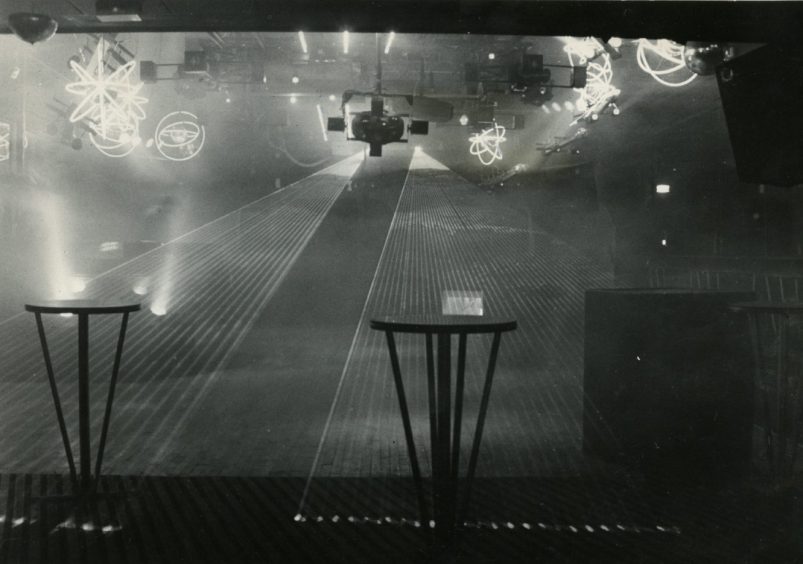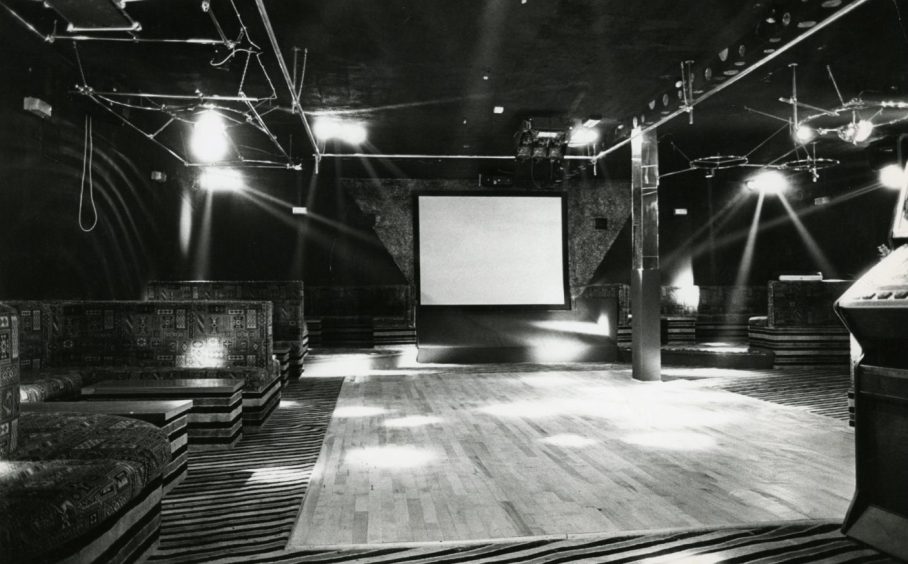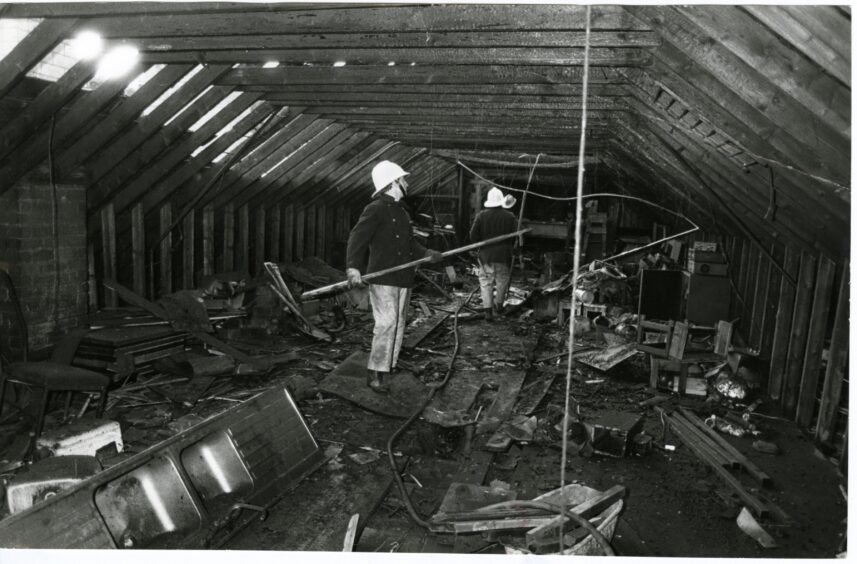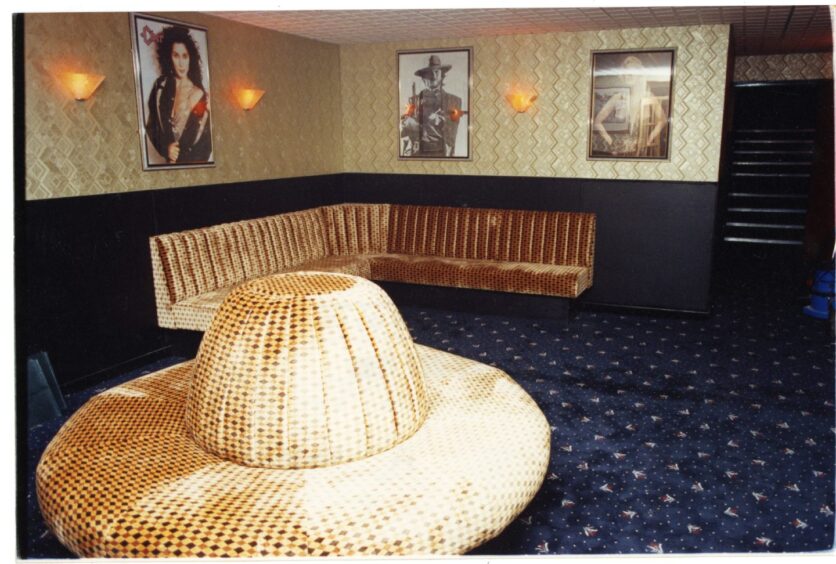
The Fountain Disco opened its doors 40 years ago and offered Dundee clubbers “mind-blowing light and sound effects” and cheap drinks.
“Scotland’s best lighting system” consisted of space-lighters, atomic neon balls and cosmos balls which was operated by a former DJ at the Camden Palace in London.
There were smoke and bubble machines and the extensive floorspace of the Brown Street building was developed to create a “total disco atmosphere”.
The 1,000-capacity venue opened for the first time in December 1983 in the same week Fat Sam’s emerged on the Dundee nightclub scene at South Ward Road.
The Fountain Disco was open from Wednesday to Sunday from 8pm to 2am.
Admission was £2.50.
Pints and nips were 50p during the 9pm to 10pm “happy hour”.
Clubbers were told to remember the three B’s: “Be Early, Be Smart, Be Over-18”.
Jeans were allowed but customers were expected to “dress smartly to avoid disappointment” to pass the Fountain’s “tight vetting process”.
The Friday Night Fling featured all drinks at 50p; Saturday night was ‘Party Night’, including what was described as a “crazy half-hour of total madness” from 1am-1.30am.
Sunday was over-20s night with ladies’ admission £1 and vodka 40p a nip.
The grand opening was an all-ticket affair but there was disappointment 48 hours beforehand when special guest Jeffrey Daniel pulled out after falling ill with the flu.
Daniel performed the moonwalk before Michael Jackson and introduced body-popping to Europe and the UK while selling over 25 million records with R&B group Shalamar.
Some drink prices were cut to 50p “as an apology to the ticket-holders”.
An advertising feature in the Evening Telegraph said the carpets were blue and yellow striped and the seating was “an attractive brown patterned material“.
“On entering the building, the customer is unaware what will emerge at the top of the flight of stairs, which is the first view.
“What opens to the eye at the top is a large seating bar lounge, the first of three such lounges on the premises.
“In the centre of this first lounge is a large fountain, surrounded by brown and blue décor and extensive seating.
“A turn to the left past the kitchen and the customer is confronted with a huge dance area, with bar.
“Behind this area are a further two seating areas, with another bar.
“However, the centrepiece of the development is the dance area itself, with raised DJ console and the lighting system, which incorporates the most advanced systems in operation, and a laser show.”
Manager Alex Savill set up the Fountain in conjunction with Bacchus Entertainment and said most of the Dundee equipment was bought at the European Light Show.
“It consists of space-lighters, atomic neon balls and cosmos balls, and is attached to a
raising rig that can lift the whole system five feet towards the ceiling,” he said.
“This is so the two kilowatt laser can come into operation.
“The whole lighting system is 1,000 watts strong. and the lighting in the seated lounges is linked so that the whole disco has the sound-to-light system.”
The 7,000 watt sound system was “one of the most powerful in the country”.
The Fountain tables were all lined with lighting
The music DJ was Gary Clark, who arrived from one of Norway’s top discos, and lights jockey was Kool Breez, who used to operate the lighting system at London’s Camden Palace.
“The bars are all lined with neon tube lighting, and there are also neon tube pictures all around the disco,” said Alex.
“With the help of a smoke machine, the lighting directly above the bars will create a sort of pillar effect, which is very attractive.
“The tables in the dance area are all lined with lighting.”
The nightspot played new wave, pop and disco while large screens would show music videos from the likes of Duran Duran, Spandau Ballet, Michael Jackson and Wham!
The Evening Telegraph said on either side of the dance floor were “two huge mirrors” and the rest of the walls were decorated with “glittering blue material”.
A staff of 30 were employed including 12 for the three bars and eight security staff, “linked by hand radios and backed up with CCTV”.
“I stress that it will not be like Fort Knox,” said Alex.
“The security is to protect both the staff and the customers.
“We will have a lot of people here, after all.
“The dress restrictions here are not too strict – jeans are allowed but we expect customers to be neat and tidy.”
The unemployment rate in Dundee was 15% when opening in December 1983 and Alex was asked if he was confident they would get enough people through the door.
“A disco is a fantasy world, a place to escape to, and we are confident that people will come here, even if it is only for one night a week,” he said.
“Bar prices will be no more than prices in other lounge bars.
“Entry at peak times will be £2.50.
“This will, in time, be scaled – people coming early will pay less to get in.”
Triumph then tragedy for Dundee nightclub the Fountain
The Fountain sold the 1980s dream after luring in Dundonians with an irresistible mix of cheap drinks, pounding chart music and the best light show in Scotland.
The Fountain was Scottish Disco of the Year in 1984 before tragedy struck on June 25 1985 when fire ripped through the upper floor and completely destroyed the roof.
In the video lounge, large monitors were completely melted by the intense heat.
Carpets and fittings throughout were completely destroyed by smoke and water.
The Fountain was insured for £1 million and remained closed for several months.
It reopened in April 1986 following repairs and improvements which cost £160,000.
The Fountain changed its name and became Dirty Den’s in 1988 – named after the EastEnders character – with admission £7.50 and a free bar the whole night.
The club later changed its name to Oscars (fondly remembered as Dirty Oscars) and established itself as a key hub within the city’s thriving live music scene in the 1990s.
Oscars changed management in 1996 and immediately launched Takeover on Wednesdays for students and Hotel Juno on Thursdays, playing the best in house music.
Further name changes followed from 1996, first to the Colosseum, dedicated to playing house music, and finally Oxygen, which was aimed at the independent dance scene.
Oxygen quickly built up its clientele away from the mainstream and put on successful hip-hop and drum and bass nights which proved a hit with underground party-goers.
Nothing lasts forever, though.
The old-fashioned nightclub was dying out in the 2000s.
Oxygen closed its doors for good and the building has been empty for many years.
The music stopped and the structure slowly decayed.
A bid was submitted to Dundee City Council in December 2022 to demolish the crumbling building to make way for 72 flats and shops.
Perhaps, if the application is successful, future residents and shoppers will go about their business to the echo of distant disco days.




![Photo shows dancefloor area of Oscar's Nightclub]](https://wpcluster.dctdigital.com/wp-content/uploads/sites/54/2023/12/H250-1990-10-02-Oscars-Nightclub-Dundee-CDCT_38503780-scmw2w3v-e1702210372183.jpg)

Conversation